We analyzed Spotify and Tidal to see which streaming service is best for you.
Spotify and Tidal both stand as prominent players in the music streaming industry, offering diverse content, from music and podcasts to videos.
However, they differ greatly regarding audio quality and subscription plan types, making it hard to choose between them.
This article will help clear up the confusion, comparing the two services simply so you can decide which one is right for you. Let’s dive right in!
- Spotify vs. Tidal: Comparison Overview
- Spotify Offers More Value for Money
- Tidal Stands Out With Lossless Audio
- Tidal Takes a Slim Lead in Content Variety
- Spotify’s Music Discovery Is Topnotch
- Both Spotify and Tidal Are Easy to Use
- Both Spotify and Tidal Provide Many Extra Features
- Spotify vs Tidal: Which Should You Go For?
- FAQs
- Spotify vs. Tidal: Comparison Overview
- Spotify Offers More Value for Money
- Tidal Stands Out With Lossless Audio
- Tidal Takes a Slim Lead in Content Variety
- Spotify’s Music Discovery Is Topnotch
- Both Spotify and Tidal Are Easy to Use
- Both Spotify and Tidal Provide Many Extra Features
- Spotify vs Tidal: Which Should You Go For?
- FAQs
Spotify vs. Tidal: Comparison Overview
| Category | Spotify | Tidal |
|---|---|---|
| Free Plan | Yes | Yes (US only) |
| Premium Individual Plan | $10.99/month | $10.99/month (HiFi) $19.99/month (HiFi Plus) |
| Premium Family Plan | $16.99/month | $16.99/month (HiFi Family) $29.99/month (HiFi Plus Family) |
| Premium Student Plan | $5.99/month | $5.99/month (Student HiFi) $9.99/month (Student HiFi Plus) |
| Special Plans | Premium Mini (~$0.46/week) Premium Duo ($14.99/month) | Military & First Responder HiFi ($5.99/month) Military & First Responder HiFi Plus ($11.99/month) |
| Availability | 180 countries | 61 countries |
| Maximum Audio Quality | 320 kbps | 16-bit, 44.1 kHz (HiFi) 24-bit, 192 kHz (HiFi Plus) |
| Amount of Music Content | 100 million tracks | 100 million tracks |
| Podcast and Audiobook Availability | 5 million podcasts 350,000 audiobooks | 25 podcasts 650,000 videos |
| Exclusive Features | Spotify Wrapped, Time-synced lyrics, Smart Shuffle, AI DJ | Tidal Magazine, My Rewind, Song credits, My Activity, Album commentaries, Documentaries, Tidal Venues |
| Social Features | Friend Activity, Social profiles, Spotify Jam, Collaborative playlists | Social profiles |
| Average Artist Payout | $0.0033 | $0.12 |
| App Links | Android, iOS, Mac & Windows | Android, iOS, Mac & Windows |
Spotify Offers More Value for Money
Spotify outshines Tidal in this category for being widely available and having more affordable options.
First, the budget-friendly Premium Duo and Mini plans provide full access to Spotify’s extensive content at a lower price. Spotify is also more accessible, offering its free plan in every country it operates. In contrast, Tidal’s free plan is exclusive to US residents, and its global presence is limited.
That said, all paid plans on both services offer the following similar features:
- Ad-free, on-demand playback
- Over 100 million songs
- Access to all platform content
- Download option for offline listening
However, key differences set these platforms apart, such as:
- Tidal’s HiFi Plus tier: Spotify Premium and Tidal HiFi plan prices are the same, but Tidal charges more for CD-quality audio on its HiFi Plus plans. This lets you enjoy immersive sound in formats like HiRes FLAC, Dolby Atmos, and Sony 360 Reality Audio.
- Plan variety: Tidal offers a 50% discount on HiFi and HiFi Plus plans for Military and First Responders, whereas Spotify doesn’t have special plans like these.
Tidal HiFi’s CD-quality audio appeals to audiophiles and those with high-end audio gear, but it’s not a universal draw. While enhanced sound quality is a niche advantage, average listeners may prioritize a diverse content library, widespread availability, and varied subscription options – areas where Spotify often takes the lead.
Tidal Stands Out With Lossless Audio
If high-quality audio is your priority, Tidal is the better option.
Tidal HiFi provides CD-quality audio at the same price as Spotify Premium and HiFi Plus extends to HiRes FLAC audio up to 192 kHz. Meanwhile, Spotify offers multiple audio quality settings, including a 24 kbps option for saving data, but it maxes out at 320 kbps. Although pricier, the Tidal is worthwhile for those prioritizing pristine sound quality.
Here’s an overview of the audio quality settings on these apps for your reference:
| Subscription Plan | Audio Setting | Audio Format |
|---|---|---|
| Spotify Premium | Automatic (depends on connection) | Ogg/Vorbis |
| 24 kbps (Low) | Ogg/Vorbis | |
| 96 kbps (Normal) | Ogg/Vorbis | |
| 160 kbps (High) | Ogg/Vorbis | |
| 320 kbps (Very High) | Ogg/Vorbis | |
| HiFi | 96 or 320 kbps (Low) | AAC |
| 16-bit, 44.1 kHz (High) | FLAC | |
| HiFi Plus | 96 or 320 kbps (Low) | AAC |
| 16-bit, 44.1 kHz (High) | FLAC | |
| 24-bit, 192 kHz (Max) | HiRes FLAC |
Despite using lossy audio formats, Spotify’s sound quality is decent in my experience. Its data usage is also efficient, consuming only 150 MB per hour at its highest audio setting. This gave me smooth playback even at a 49 Mbps connection speed.
Conversely, Tidal’s FLAC and HiRes FLAC formats deliver excellent sound quality, but the HiFi and HiFi Plus consume anywhere from 635 MB to 18.20 GB per hour. On slow connection days, I noticed more buffering when skipping tracks.
Nonetheless, if audio quality is your top priority and you don’t mind occasional buffering or have access to good internet, Tidal is the clear winner. But Spotify holds its ground firmly for a balance of quality and efficiency.
Tidal Takes a Slim Lead in Content Variety
Tidal’s video content offers more value to music fans, providing deeper insights into favorite artists and music through documentaries and behind-the-scenes content.
In hindsight, Spotify and Tidal are equal in terms of the amount of music content. Both platforms have extensive libraries offering 100 million tracks. They have good selections of popular and independent music to satisfy all music fans and feature well-curated playlists and exclusive podcasts.
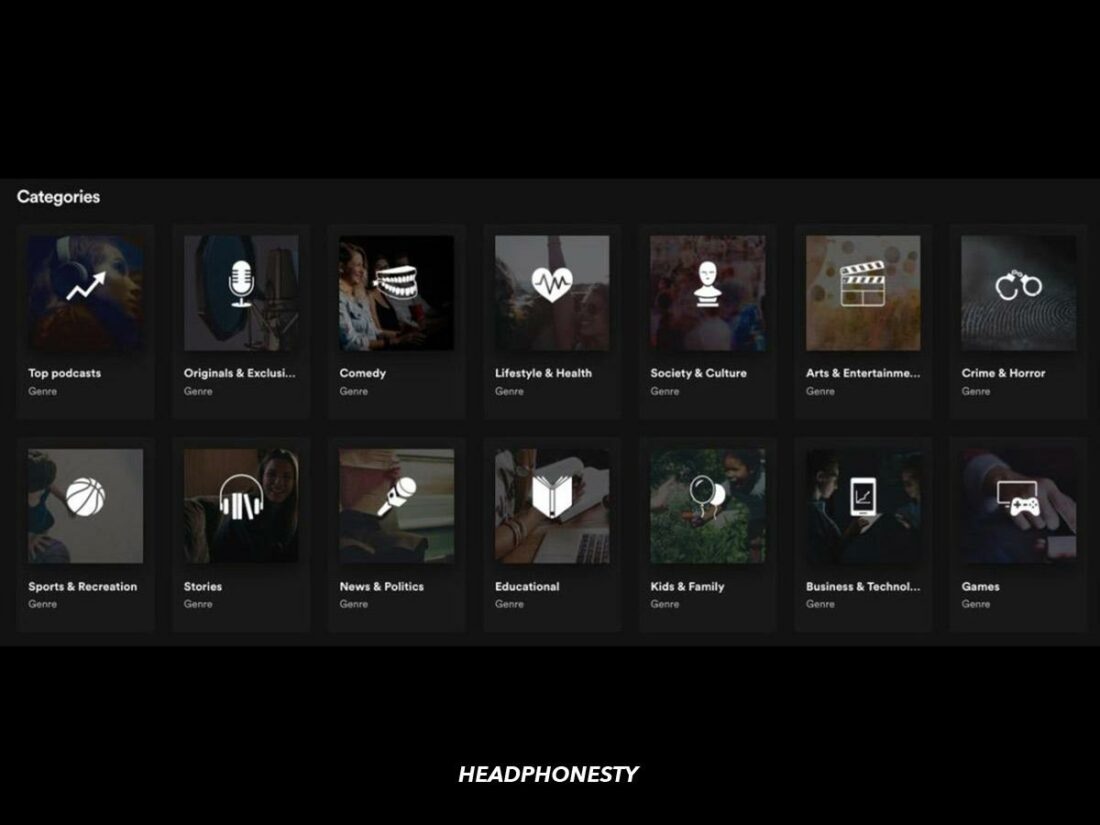
However, the differences between these two apps are notable. These include the following:
- Spotify has more podcasts (5 million titles) than Tidal (25 titles).
- Spotify offers audiobooks, whereas Tidal doesn’t.
- Tidal has an extensive video collection that includes music videos, original content, album commentaries, and documentaries.
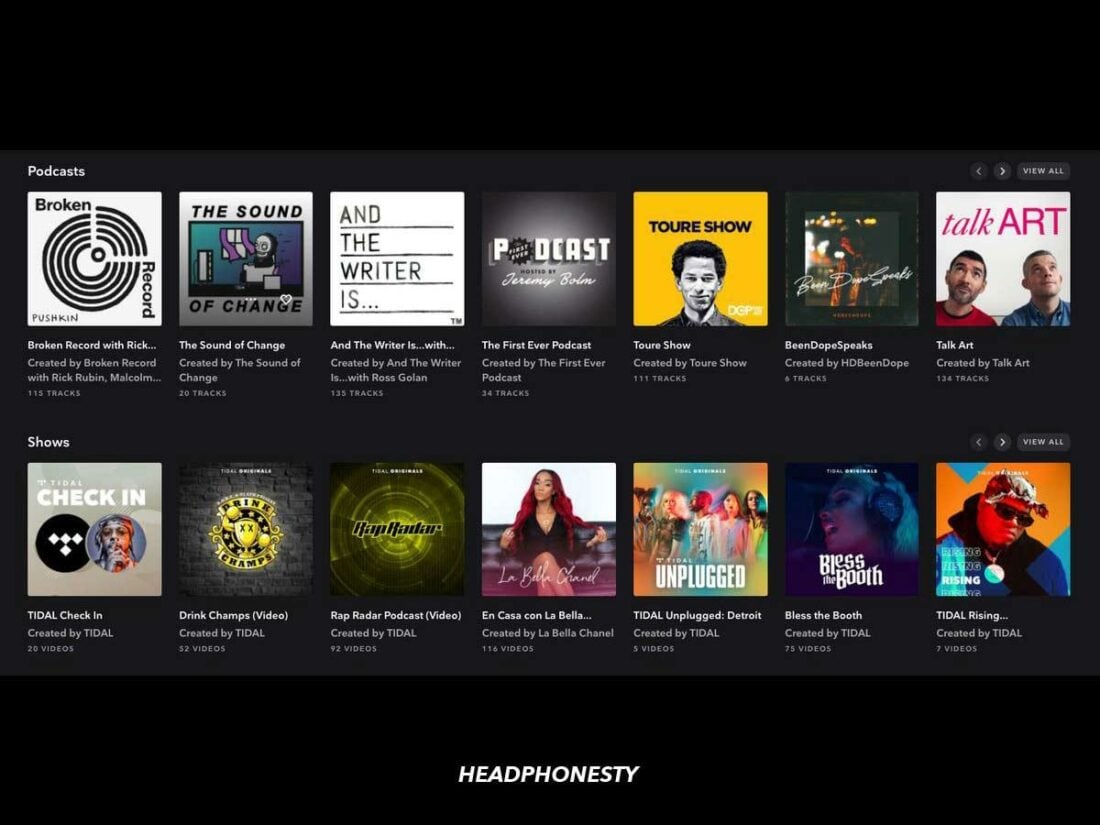
Furthermore, Spotify’s music curation is broader, with 67 music genres, compared to Tidal’s 25 genres. Tidal, though, is more focused on specific genres, such as Hip-Hop. It provides detailed playlists for listeners seeking a deeper exploration of particular music styles.
All in all, Spotify offers more variety with podcasts and audiobooks. But Tidal shines in its in-depth and curated approach to music genres, ideal for music enthusiasts valuing substance over volume.
Spotify’s Music Discovery Is Topnotch
Spotify wins this category due to a stronger emphasis on personalization and an abundance of tailored content.
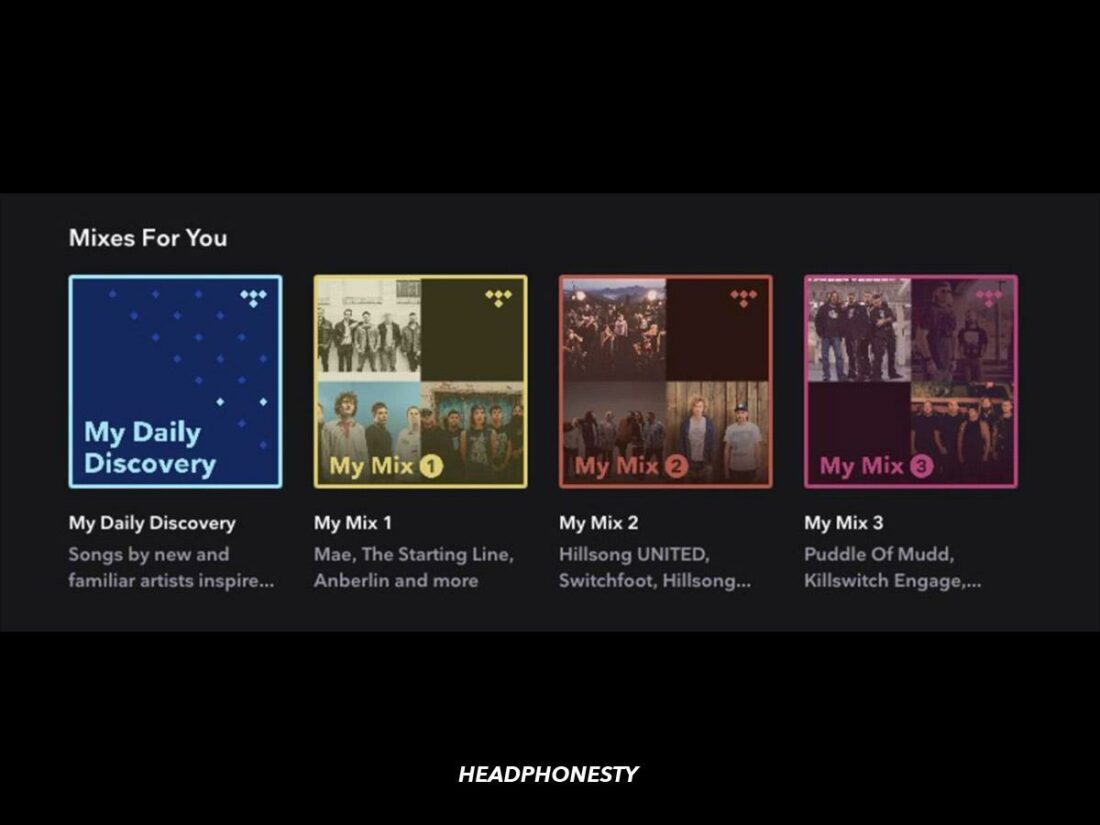
Spotify’s ‘Search’ and Tidal’s ‘Explore’ are very similar. There are personalized song recommendations within playlists on both services. I often use this feature on Spotify and found Tidal’s suggestions equally impressive. The services promote emerging artists through Spotify’s RADAR and Tidal Rising and provide a ‘Fans Also Like’ section on artist profiles for discovering similar music.
Here’s an overview of all the other discovery features on Spotify and Tidal:
| Discovery Feature | Spotify | Tidal |
|---|---|---|
| “Search” (Spotify) “Explore” (Tidal) |
|
|
| Playlist Recommendations |
|
|
| Personalized Mixes |
|
|
| Artist Recommendations |
|
|
The difference between the two lies in how they make recommendations. Spotify uses a hybrid algorithm that analyzes a song’s language and raw audio combined with your in-app listening habits. Thanks to this, Spotify has an abundance of personalized playlists. The ‘Made For You’ section is especially ideal for adventurous listeners.
Tidal, on the other hand, prioritizes human-curated playlists. And although it has personalized playlists, like ‘My Daily Discovery’ and ‘My Mix,’ they’re fewer in number than Spotify. In contrast, the sheer number and variety of editorial playlists on Spotify makes you feel like you’re getting more value for your subscription.
Both Spotify and Tidal Are Easy to Use
Spotify and Tidal have user-friendly interfaces, offering a seamless experience for all users. Both streaming platforms’ clean, intuitive designs make essential features easily accessible, ensuring straightforward navigation and ease of use.
The desktop apps for both services feature a sidebar with links to the main sections, your library, and playlists. Mobile app users will find this navigation bar at the bottom. There’s also a drag-and-drop function to easily add songs or albums to playlists and detailed drop-down menus for various actions.
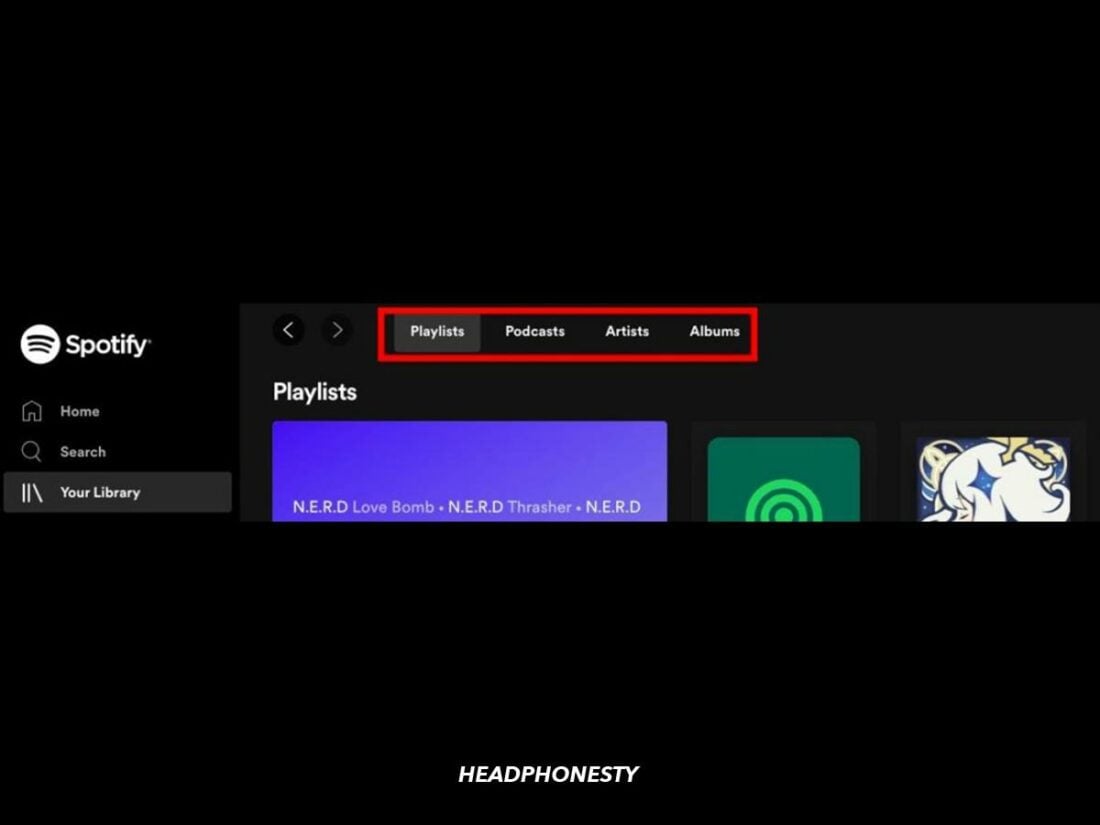
In Spotify’s ‘Your Library,’ content filters allow sorting by playlist, artist, album, or podcast, accessible on mobile. Alternatively, Tidal’s ‘My Collection’ displays filters on the sidebar for quicker access.
Furthermore, Tidal’s artist profiles offer extensive insights. Besides discography and playlists, there’s a ‘Social’ section at the bottom with links to the artist’s social accounts. Quick links to ‘Artist Radio,’ ‘Credits,’ and more are available for easy navigation.
Lastly, I like Tidal’s audio quality button as it allows quick audio adjustments without navigating to app settings. It’s accessible from the ‘Now Playing’ bar on desktop and screen on mobile. All in all, the two services are well-designed and user-optimized.
Both Spotify and Tidal Provide Many Extra Features
The two services provide interesting extra features for all types of music fans. Here are some notable ones:
- Spotify Wrapped: This feature provides an annual summary of your music listening habits, showcasing your unique preferences that can be shared on social media. Tidal’s My Rewind, seen in the mobile app’s My Activity section, offers a simpler view of your top tracks.
- Social features: Spotify offers a richer social experience by allowing users to share playlists, host real-time listening parties with Spotify Jam, collaborate on playlists, and stay updated on your friends’ current listens with Friend Activity. Tidal allows users to share tracks on Facebook and Instagram but lacks other interactive and collaborative elements.
- Tidal Magazine: Tidal offers unique content, including an online magazine with essays and articles on music. Users can easily access featured write-ups within the app and directly jump to a web browser for an extended read.
- Music insights: Tidal offers album commentaries, documentaries, contributor mixes, and an incredibly comprehensive song credits feature, making it a haven for serious music lovers.
- Virtual content: Both Spotify and Tidal offer live-streamed concerts. Spotify introduced this feature in 2021 with a series of virtual events. However, Tidal is more seasoned, with exclusive access to live events and meet-and-greets through the Tidal Venues.
Some prefer Spotify for its social features and easy music sharing, while others favor Tidal for its insightful content and unique fan experiences. Ultimately, your choice depends on your listening preferences.
Spotify vs Tidal: Which Should You Go For?
Here’s a summary of everything you can get from both platforms:
| Spotify | Tidal |
|---|---|
|
|
Spotify offers more features and subscription perks at a lower cost, making it ideal for budget-conscious users. It’s preferred for music discovery and personalized listening, especially for those prioritizing these over sound quality.
In addition to engaging social features, avid podcast listeners will also get great satisfaction from Spotify’s massive collection. So, if you enjoy podcasts and a personalized music experience, Spotify is tailored for you.
Tidal, in contrast, provides great value with its free plan and affordable high-resolution audio. Moreover, it has in-depth music curation catering to dedicated fans who want to connect with artists, their music, and their stories.
That said, if you seek pristine audio quality, value artist narratives, and enjoy a more curated and intimate music experience, Tidal is your match.
FAQs
- How much do Spotify and Tidal pay artists?
- Will Spotify go lossless?
- How long do Tidal downloads last?
- Why is Tidal not as popular?
How much do Spotify and Tidal pay artists?
Spotify pays roughly $0.0033 per stream, one of the industry’s lowest rates. The lower payouts result from including free streams and the app’s high popularity in countries with lower subscription fees. In contrast, Tidal’s $0.12 per stream is among the highest of all music streaming platforms.
Will Spotify go lossless?
Yes, Spotify’s HiFi tier, Supremium, may launch before the end of 2023. The new plan costs $19.99 and will include 24-bit lossless audio, AI-driven playlists, new sorting filters, mixing tools, and listening stats.
How long do Tidal downloads last?
Songs you’ve downloaded for offline listening remain on the app for only 30 days. As such, connecting online at least once a month is best to keep your downloads.
Why is Tidal not as popular?
Tidal entered the music streaming scene late, facing stiff competition from established music streaming services. Its premium pricing and high-fidelity audio targeted a niche audience, potentially alienating budget-conscious listeners. Additionally, its music recommendations were seen as less engaging, and its limited availability also restricted its reach.
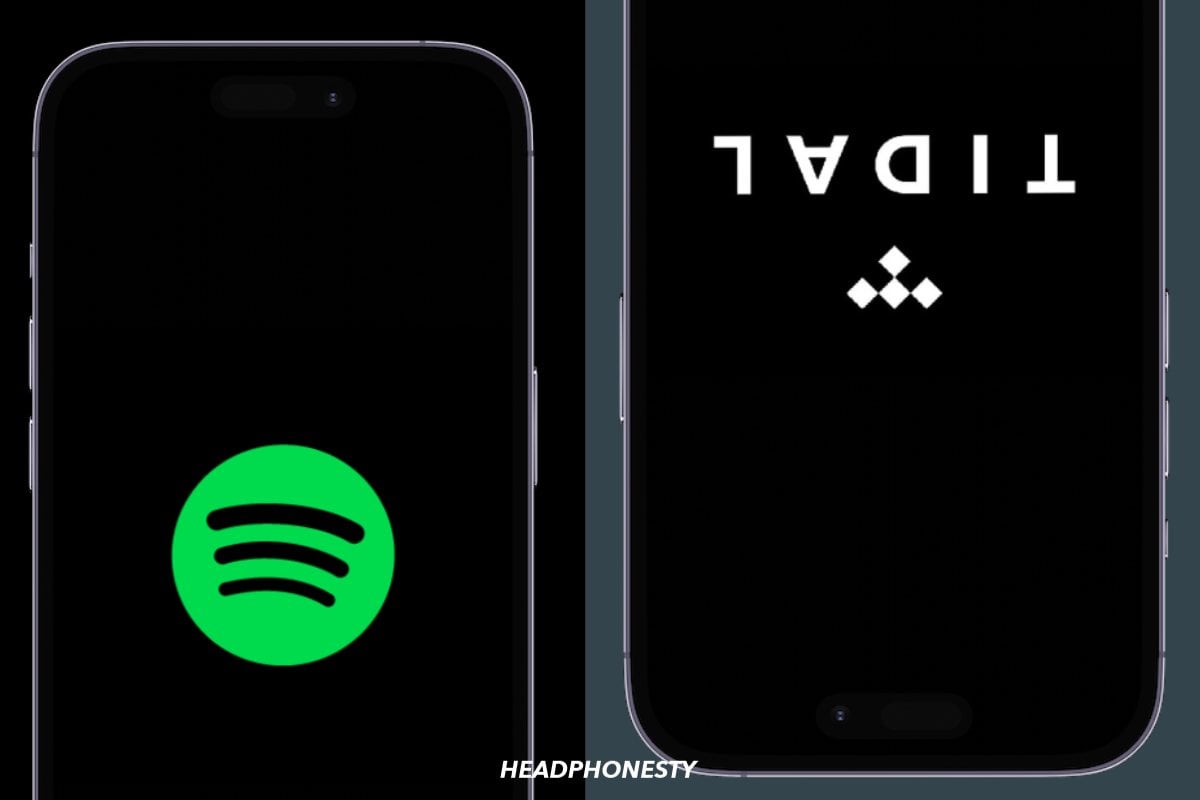
You forgot one important question: Do TIDAL and SPOTIFY pay artist´s royalties in time ? Answer: Spotify YES, Tidal NO !!!!
do not post such claim without backing it up with evidence.
Great read, thank you. One thing you didn’t mention is how well the apps perform. On Android I have had nothing but problems trying to save my downloads to an external SD card. Look it up: countless Android users have the same issue. This is why I am switching to Tidal.
Well there’s another area where Tidal is over Spotify: DJ streaming. While Spotify, if I am not mistaken, is connected only with Algoriddim, Tidal is more open to the DJ scene.
What does this even mean dude? Did you put your own spin on algorithm to include Riddim (as in style of dubstep)? Both of them are garbage when it comes to the DJ scene. I assume you’re talking about unreleased music? SoundCloud all the way bud.
Algoriddim is a DJ software available on IOS and Windows devices. You can DJ with Spotify as a streaming source.
Tidal can be used as a source for a larger number of DJ sotware platforms including VirtualDJ, Serato and Engine.
One thing missing on this review – Local Contents , while both might be well represented in EU / US , it cannot be said so for many other region .. well as an Asian residing in the East Asian region and very often travel on work and personal clause to South East Asia , I look for not just a service that provide me with collection of Classicals, Jazz and others but also contents that’s relevant to my locale – upon that Tidal is far behind Spotify ( at least for Asia ) J-Pop and K-Pop is represented at best on a so-so level , Mando-Pop and Canto-Pop are marginal at best and meh if you dig deep , let alone the relevant Chinese, Japanese, & Korean classicals and retros ; and AFAIK, even worse for the South East Asian region
Another gene big in Asia and fast becoming big in the world is Anime ( both the Anime and their Music ) and the also related ACG gene , when I try to search for ムーンライト伝説 ( the main Theme of Sailor Moon ) , and ” Only my Railgun ” two of the classics in this gene , I’ve found that Tidal do not even had the artist tracks , and equally non existence of many Game Music
It does not matter how good the audio quality , so long the content is not there its a big deficiency and even greater deficiency when you view the wider and much larger mass consumer market
Thanks for your comment!